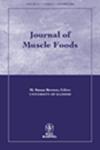The research was done to investigate the gel properties of surimi-like materials (SLM) from breast muscle of chicken, and semimembranosus muscle of porcine and bovine. Differences in the thickness and diameter of muscle fibers from three muscles were observed using field emission scanning electron microscope. As muscle fiber thickness decreased, gel microstructure of cooked SLM had smaller particles of amorphous proteins that might be related to hard and strong gel structures. These results implied that the gel texture seen in the SLM was dependent on muscle fiber types from different animals. The myosin ratio was increased with the decrease of red muscle fiber-type ratio, i.e., beef > pork > chicken. Amino acid composition analysis showed significantly (P < 0.05) higher proline percentage among the hydrophobic amino acids in chicken compared with pork and beef. Data implied that muscle fiber types affected the gel-forming ability of SLM.
Gel hardness of cooked surimi-like materials (SLM) was increased as pH decreased. The different pH of animal muscles might be related to differences in muscle protein composition and species. The different pH had effects not only on the sarcoplasmic protein in SLM after washing, but also on the functionality of myofibrillar proteins after cooking. Porcine muscle had the thickest muscle fibers, whereas bovine muscles had the smallest fiber diameter. This difference was correlated to gel hardness and microstructure of cooked SLM. The myosin ratio in the myofibrillar proteins was lower in SLM from beef than those from chicken and pork. The myosin ratio was increased as the red muscle fiber ratio decreased. Therefore, these results suggested that the myosin ratio in SLM depended on the muscle fiber type in raw muscles, and resulted in better gel-forming ability and texture of cooked SLM.


